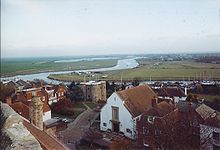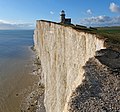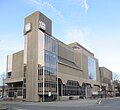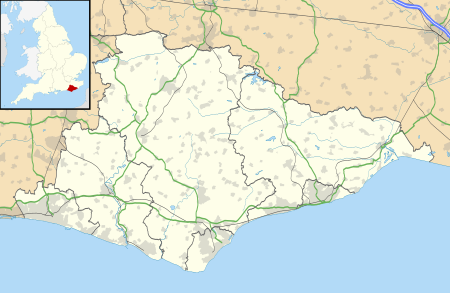Portal:East Sussex

East Sussex is a ceremonial county in South East England. It is bordered by Kent to the north-east, West Sussex to the west, Surrey to the north-west, and the English Channel to the south. The largest settlement is the city of Brighton and Hove, and the county town is Lewes.
The county has an area of 1,792 km2 (692 sq mi) and a population of 822,947. The latter is largely concentrated along the coast, where the largest settlements are located: Brighton and Hove (277,105), Eastbourne (99,180), and Hastings (91,490). The centre and north of the county are largely rural, and the largest settlement is Crowborough (21,990). For local government purposes, East Sussex comprises a non-metropolitan county, with five districts, and the unitary authority of Brighton and Hove. East Sussex and West Sussex historically formed a single county, Sussex.
East Sussex is part of the historic county of Sussex, which has its roots in the ancient kingdom of the South Saxons, who established themselves there in the 5th century AD, after the departure of the Romans. Archaeological remains are plentiful, especially in the upland areas. The area's position on the coast has also meant that there were many invaders, including the Romans and later the Normans, following the defeat of the English army by William the Conquerer at the Battle of Hastings in 1066. Earlier industries included fishing, iron-making, and the wool trade, all of which have declined or been lost completely. (Full article...)
Selected article
Rye is a town and civil parish in the Rother district of East Sussex, England, two miles (three kilometres) from the sea at the confluence of three rivers: the Rother, the Tillingham and the Brede. An important member of the mediaeval Cinque Ports confederation, it was at the head of an embayment of the English Channel, and almost entirely surrounded by the sea.
At the 2011 census, Rye had a population of 4,773. Its historical association with the sea has included providing ships for the service of the Crown in time of war, and being involved in smuggling. The notorious Hawkhurst Gang used its ancient inns The Mermaid Inn and The Olde Bell Inn, which are said to be connected to each other by a secret passageway.
Those historic roots and its charm make it a tourist destination, with hotels, guest houses, B&Bs, tea rooms, and restaurants. Rye has a small fishing fleet, and Rye Harbour has facilities for yachts and other vessels. (Full article...)
Selected images
Selected biography
Archibald Stansfeld Belaney (September 18, 1888 – April 13, 1938), commonly known as Grey Owl, was a popular writer, public speaker and conservationist. Born an Englishman, in the latter years of his life he passed as half-Indian, claiming he was the son of a Scottish man and an Apache woman. With books, articles and public appearances promoting wilderness conservation, he achieved fame in the 1930s. Shortly after his death in 1938, his real identity as the Englishman Archie Belaney was exposed. He has been called one of the first pretendians.
Moving to Canada as a young man, Belaney established himself as a woodsman and trapper, before rising to prominence as an author and lecturer. While working for the Dominion Parks Branch of Canada in the 1930s, Belaney was named the "caretaker of park animals", first at Riding Mountain National Park in Manitoba and then at Prince Albert National Park in Saskatchewan. His views on wilderness conservation, expressed in numerous articles, books, lectures and films, reached audiences beyond the borders of Canada, bringing attention to the negative impact of exploiting nature and the urgent need to develop respect for the natural world. He was particularly concerned about the plight of the beaver (Canada's national animal), which by the 1920s had been hunted almost to extinction.
Recognition of Belaney includes biographies, academic studies, historic plaques in England, Ontario and Quebec, and a film based on his life, directed by Richard Attenborough. (Full article...)
Did you know that
General images -
List articles

- List of hills of East Sussex
- List of local nature reserves in East Sussex
- List of monastic houses in East Sussex
- List of museums in East Sussex
- List of Parliamentary constituencies in East Sussex
- List of places in East Sussex
- List of settlements in East Sussex by population
- List of Sites of Special Scientific Interest in East Sussex
- List of windmills in East Sussex
Subcategories
Settlements map
Things you can do
- Add to this portal.
- Join the Sussex WikiProject
Topics
Related portals
Associated Wikimedia
The following Wikimedia Foundation sister projects provide more on this subject:
-
Commons
Free media repository -
Wikibooks
Free textbooks and manuals -
Wikidata
Free knowledge base -
Wikinews
Free-content news -
Wikiquote
Collection of quotations -
Wikisource
Free-content library -
Wikiversity
Free learning tools -
Wikivoyage
Free travel guide -
Wiktionary
Dictionary and thesaurus

























































































